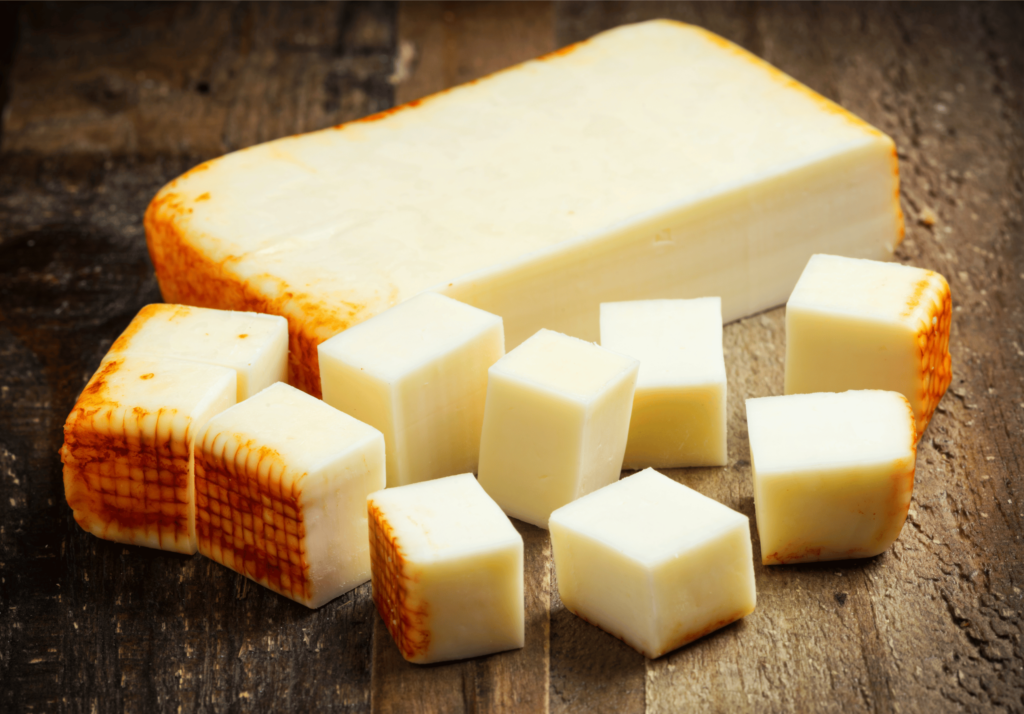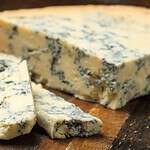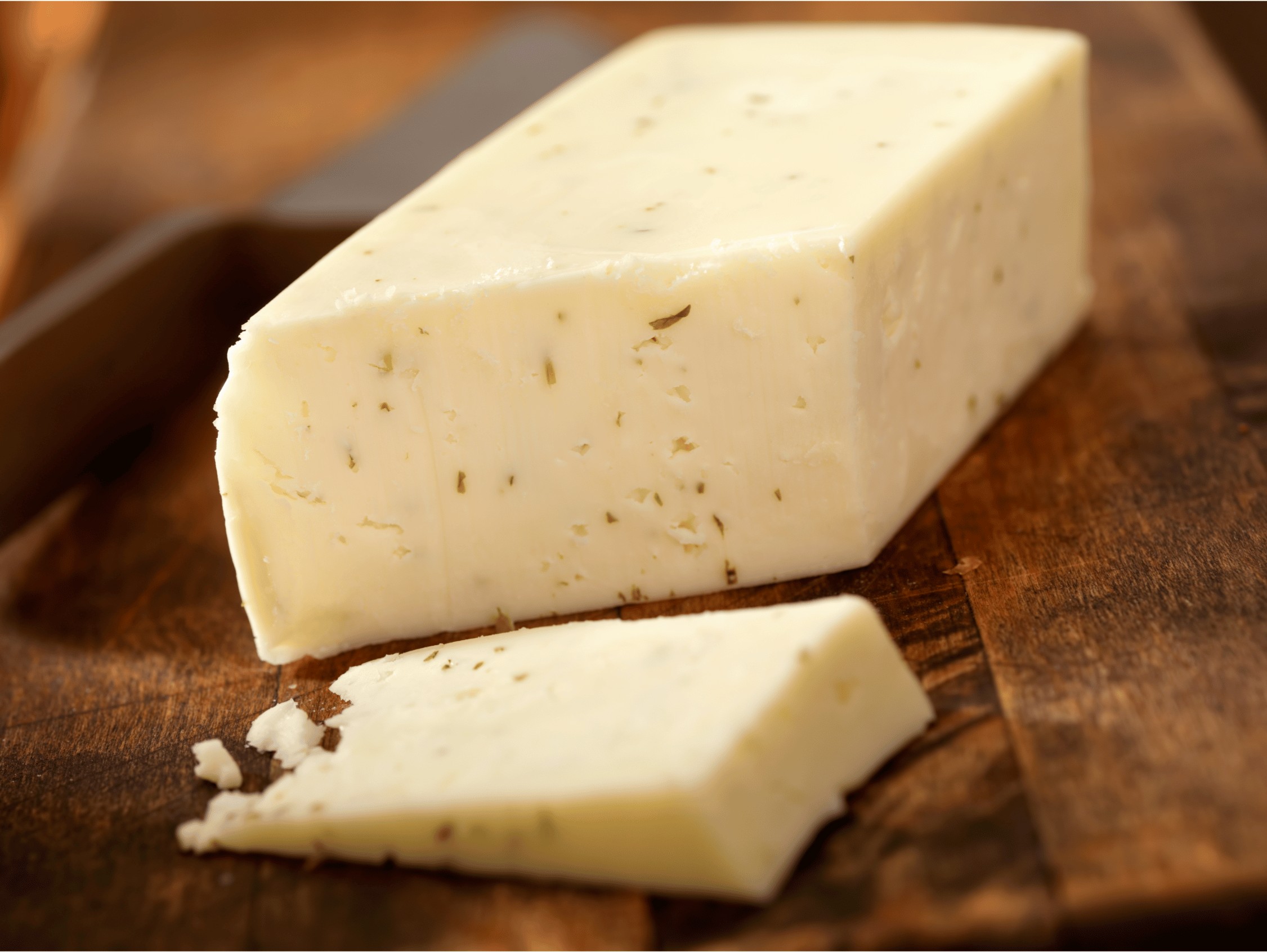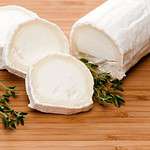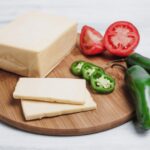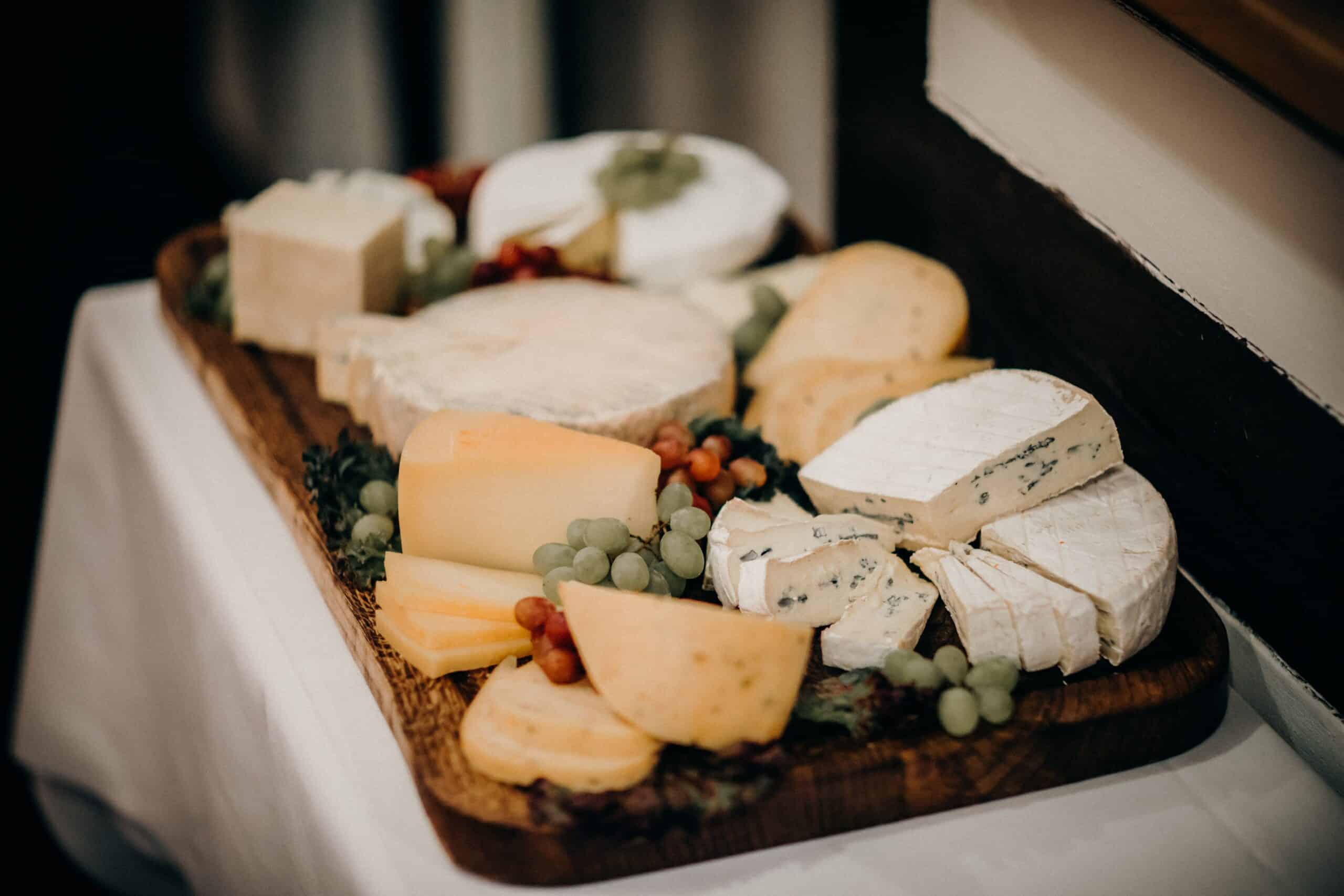Muenster cheese, not to be confused with the French Munster cheese, is a semi-soft cheese that originated in the United States. It’s named after an American imitation of the Alsatian Munster cheese but has since carved out its own identity in the cheese world. With a smooth, pale yellow interior and an orange rind, Muenster is recognizable and widely favoured for its mild flavor and creamy texture.
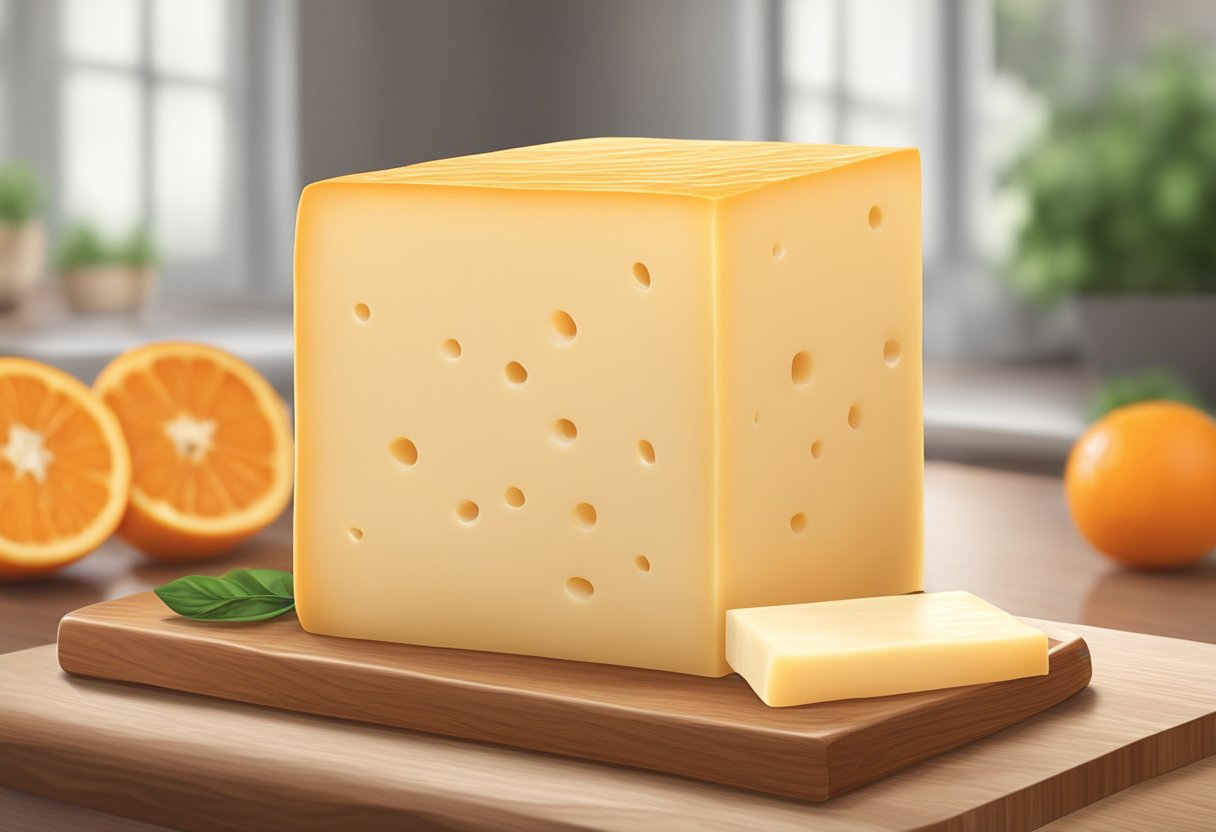
Traditionally made from cow’s milk, the cheese is known for its versatility. It can be consumed at various stages of aging, and its taste ranges from mild to sharp, depending on its maturity. The pale interior is often dotted with small holes, indicative of the cheese-making process, while the edible rind provides a slightly stronger flavor.
Muenster cheese is a staple in many dishes and is especially popular in sandwiches and on burgers due to its excellent melting properties. Its gentle flavor profile allows it to blend well with other ingredients, making it a favorite among those who prefer a less pungent cheese.
Key Takeaways
- Muenster cheese is a versatile, semi-soft American cheese with a mild to sharp flavor.
- Its creamy texture and excellent melting properties make it ideal for culinary use.
- Muenster cheese is distinguishable by its smooth, yellow interior and orange rind.
History and Origin
Muenster cheese has a rich history rooted in European traditions, which later evolved with its introduction to the American market. We explore its origins from the quaint region of Alsace and its journey across the Atlantic to the United States.
Origins in France
Originating in the Alsace region of France, Muenster cheese, initially known as Munster cheese, was first crafted by Benedictine monks. Residing in the Vosges Mountains, these monks utilized their knowledge of cheesemaking to create a smooth, pale yellow cheese with a distinctive orange rind. This tradition has been maintained through generations, highlighting the region’s cultural produce.
Munster-Géromé
Munster-Géromé is a variation of Munster cheese protected by an Appellation d’Origine Contrôlée (AOC), which ensures its production adheres to strict geographic and quality guidelines. We recognize Munster-Géromé for its creamy texture and strong aroma, a result of maturation processes honed over centuries.
American Muenster
When German immigrants settled in the United States, they brought with them the craft of making Munster cheese. Adapting to local taste preferences and production techniques, the cheese transformed into what is now known as American Muenster. This version is milder and more subdued in flavor, perfect for a variety of culinary uses favored by Americans. American Muenster is less pungent and is recognized by its distinct orange-red rind, created using annatto, a natural food coloring.
Characteristics of Muenster Cheese

Muenster cheese is renowned for its distinct color, creamy texture, and versatile flavor profile which makes it a favorite among cheese enthusiasts. In terms of nutrition, it offers a balance of protein, fats, and carbohydrates.
Color and Rind
The rind of Muenster cheese is typically an orange hue, achieved by adding annatto, a natural colorant. This vibrant rind encases the pale, soft interior. The color contrast is not only appealing but also a sign of proper aging.
Texture
Muenster cheese falls into the category of semi-soft cheese. We can easily identify it by its smooth and creamy consistency. The moisture content contributes to the cheese’s pliable and supple nature, making it easy to slice and melt.
Flavor Profile
The taste of Muenster cheese is generally considered mild with subtle earthy notes. This mildness makes it an adaptable ingredient in various culinary applications. Mild when young, the flavor intensifies as it ages.
Nutritional Information
Concerning its nutritional profile, Muenster cheese contains a considerable amount of protein and fat content, which can vary depending on the specific product. It also includes a moderate level of carbohydrates. We can summarize its key nutritional elements in a table:
| Nutrients | Content per 100g approx. |
|---|---|
| Protein | 24g |
| Total Fat | 30g |
| Carbohydrates | 1.1g |
| Moisture | Varies |
Muenster cheese thus offers a nutritious option that is rich in protein and fats, which are important for a balanced diet.
Production and Aging Process
The production and aging process of Muenster cheese are crucial for developing its unique flavor and texture. We’ll examine the journey from milk to matured cheese, focusing specifically on pasteurization, the making of the cheese itself, and the ripening period that defines its character.
Milk and Pasteurization
Firstly, we collect milk, typically sourced from cows, as the foundational ingredient. For Muenster cheese, we use pasteurized cow’s milk which helps ensure safety and consistency. During pasteurization, the milk is heated to a specific temperature to eliminate pathogens. A standard procedure involves heating the milk to at least 161°F for 15 seconds, promptly followed by cooling.
Cheese Making
Turning the pasturized milk into cheese begins with the addition of a starter culture. This culture, a combination of bacteria, starts to ferment lactose into lactic acid. Next, we add rennet, an enzyme complex that coagulates the milk, separating it into curds and whey. The curds are cut and stirred to promote whey expulsion and to develop the desired texture for Muenster cheese.
Following that, the curds are pressed into molds to shape the cheese. A key step is the application of a brine solution, which helps to form the rind and imparts the initial stages of flavor. Brining involves submerging the cheese into a salt-water solution for several hours, allowing the salt to penetrate the cheese.
Aging and Ripening
Finally, the Muenster enters the aging process. We store the cheese in a humidity-controlled environment at a temperature between 50°F and 55°F. The length of the ripening period can vary; for a mild flavor, we may age the cheese for a few weeks, while for a more robust taste, we can extend to several months. During this time, the flavor and texture of the cheese develop and mature, resulting in the distinct creamy texture and mellow, yet tangy, flavor of Muenster cheese.
Culinary Uses

Muenster cheese is versatile in the kitchen, known for its smooth texture and mild flavor which melts beautifully, making it a favorite for many classic dishes. Let’s explore how to best utilize this cheese in pairings and recipes.
Pairing with Wines and Beverages
When it comes to beverages, Muenster cheese pairs well with a variety of wines and beers that compliment its creamy nature.
- Wines: Given its subtlety, a light white wine like Riesling or Pinot Noir can be a delightful accompaniment. For those who prefer red wine, a gentle Zinfandel works nicely.
- Beers: A cold Pilsner is a refreshing choice, with its clean and crisp taste cutting through the cheese’s richness.
Incorporation in Dishes
Incorporating Muenster cheese into dishes can elevate their flavor profile:
Sandwiches and Burgers: Muenster melts well, making it a go-to cheese for enhancing a classic grilled cheese, burger, or sandwich. Its good melting qualities mean it contributes to a gooey and appealing texture.
Pizza and Pasta: Whether as a topping on pizza or mixed into macaroni and cheese, Muenster’s creamy melt contributes to a rich and satisfying experience.
Breakfast and Baked Goods: A continental breakfast might feature Muenster as a soft and approachable option. It’s also a fine choice for a loaded baked potato or to create a cheese sauce for a cheeseburger or fondue.
By thoughtfully incorporating Muenster cheese into these dishes and pairings, its unique qualities can be thoroughly enjoyed.
Varietals and Comparisons

In exploring the varietals and comparisons of Muenster cheese, we’ll examine its characteristics against other cheeses and highlight regional differences.
Comparison with Other Cheeses
Muenster cheese, known for its smooth texture and mild flavor, stands apart in several ways. Its orange rind, a result of annatto coloring, distinguishes it visually from white cheeses like mozzarella and American cheese. When compared to Cheddar, which is typically more aged and has a sharper taste, Muenster provides a creamier and more buttery profile. Unlike Colby, which also has a mild flavor, Muenster often has a higher moisture content that contributes to its softer consistency.
| Cheese Type | Color | Flavor Profile | Texture |
|---|---|---|---|
| Muenster | Orange rind, pale interior | Mild, buttery | Smooth, soft |
| Cheddar | White to orange | Sharp, tangy | Firm, crumbly |
| Mozzarella | White | Delicate, milky | Soft, stretchy |
| American Cheese | Yellow to orange | Mild, creamy | Smooth, processed |
| Colby | Light orange | Mild to mellow | Semi-soft, moist |
| Mimolette | Bright orange | Nutty, fruity | Hard, crumbly |
| Red Leicester | Reddish-orange | Slightly sweet, nutty | Firm, crumbly |
Mimolette and Red Leicester both posses an intense orange color, yet Muenster is typically softer in texture and milder in flavor than these harder, nuttier varieties.
Regional Varietals
Muenster cheese originates from the Alsace region of France, where the traditional Alsatian Munster is made. This European variety is often stronger in flavor and aroma than its American cousin, and features a more intense taste due to the wash-rind process. In the U.S., our variety of Muenster is more approachable, with a subtler flavor and a consistency that is ideal for melting.
| Region | Cheese | Description | Notable Differences |
|---|---|---|---|
| Alsace, France | Alsatian Munster | Strong, pungent | Wash-rind, robust taste |
| United States | American Muenster | Mild, creamy | Annatto-colored rind, milder taste |
The Alsatian version is often enjoyed with cumin and other spices, which isn’t common for the American Muenster. We find that the American Muenster cheese’s mildness and melting qualities make it extraordinarily versatile in culinary uses.
Sensory Experience

In this section, we explore the distinctive sensory characteristics of Muenster cheese, particularly focusing on its taste, visual appeal, and texture during cooking.
Taste and Smell
Muenster cheese is renowned for its buttery flavor, which provides a mild yet pleasing taste profile. It often carries a pungent aroma, especially if aged, that cheese lovers appreciate for its intensity. The taste is smooth, with a balanced richness that is neither overpowering nor too subtle.
Visual Appeal
This cheese is easily recognizable by its orange rind, a result of annatto coloring, which encases the pale yellow interior. The contrast of colors adds a vibrant touch to cheese platters and dishes, enhancing the visual enjoyment of meals.
Texture in Cooking
When it comes to cooking, the semi-soft texture of Muenster cheese becomes even more important. It has excellent melting properties, becoming evenly molten without becoming greasy. Whether gently melted over a burger or enveloping noodles in a creamy sauce, its ability to melts well and maintain a smooth consistency is a cherished attribute.
Storage and Serving
When it comes to Muenster cheese, proper storage is crucial to maintain its quality, while serving it correctly can enhance its flavors. We will explore the best practices for preservation and offer suggestions for pairing and serving this cheese to ensure you enjoy it at its best.
Preservation Methods
Refrigeration: We keep Muenster cheese wrapped in parchment paper followed by a loose layer of plastic wrap in the refrigerator. This method allows the cheese to breathe and maintain optimal humidity. For long-term storage, thicker rinds help protect the cheese, but Muenster usually has a soft rind which requires more careful handling.
Freezing (Not Recommended): Although freezing is an option for hard cheeses, we advise against freezing Muenster cheese. Its soft texture and high moisture content mean that freezing could alter its texture and flavor.
Serving Suggestions
When ready to serve, we take Muenster cheese out of the refrigerator at least 30 minutes prior to consumption to allow it to come to room temperature, which brings out its full flavor.
Cheese Boards: We pair Muenster with a variety of fruits such as apples and pears. The cheese’s mild flavor and smooth, supple texture contrast well with the crispness of the fruit.
Sandwiches and Melts: Muenster is a great melting cheese, making it a fine choice for a turkey sandwich or tuna melt. Its creamy nature blends excellently with the savory flavors of turkey or tuna.
Wine Pairing: We suggest pairing Muenster with a medium-bodied wine like Merlot to complement the cheese’s buttery notes.
Remember, the annatto used in Muenster gives it a distinctive orange rind and a slightly nutty taste. This should be taken into account when considering pairings. Whether it’s incorporated into recipes or enjoyed on its own, Muenster’s versatility makes it a favorite among cheese lovers.
Cultural Significance
Muenster cheese has a rich cultural heritage that can be traced back to the Alsace region of France. Its production and consumption reflect a melting pot of traditions shaped by local and international influences.
Muenster Cheese in Alsace
In the Alsace region, specifically in the Vosges Mountains, Muenster cheese, or “Munster,” is a symbol of Alsatian identity. Originating from this area, Alsatian Munster is a product of profound historical significance, deeply connected with the local customs and farming practices. The cheese has been made since the Middle Ages, with methods passed down through generations.
Its creation involves specific steps: cows grazing on the rich flora of the Vosges contribute to the cheese’s distinct flavor. This Munster cheese is legally protected through an Appellation d’Origine Contrôlée (AOC), a testament to its importance in the Alsace region of France. It’s not just food; it’s a form of heritage, reflecting a blend of French and German influences due to the region’s location and history.
| Protected | Region | Significance |
|---|---|---|
| AOC | Alsace | Cultural Heritage Asset |
Muenster Cheese in America
As we cross the Atlantic to America, Muenster cheese adapted to new cultural landscapes. German immigrants brought their cheesemaking skills and traditions to the United States, where they found a new home for their craft. Primarily in Wisconsin, America’s Dairyland, they produced what is now known as American Muenster.
Unlike its Alsatian counterpart, American Muenster usually has a milder taste and a smooth, pale body with an orange rind. It became part of America’s diverse cheese portfolio, bearing a semblance to the original yet acquiring its own American character over time. We notice it commonly in delis and supermarket cheese sections, known for its versatility and ability to melt well, making it a favorite for sandwiches and burgers.
| Influence | Location | Characteristics |
|---|---|---|
| German Immigrants | Wisconsin | Birthplace of American Muenster |
| American Adaptation | America | Mild taste, smooth texture |
Frequently Asked Questions
In this section, we’re covering some common queries about Muenster cheese to help you understand its characteristics and uses better.
How is ‘Muenster’ cheese properly pronounced?
Muenster cheese is pronounced as “MUN-ster,” with the emphasis on the first syllable.
What distinguishes Muenster cheese from Munster cheese?
The main difference lies in their origins. Muenster cheese is an American imitation of the Alsatian Munster cheese, which is from the French region of Alsace. They differ in taste, texture, and the methods used in production.
What kind of flavor profile does Muenster cheese have?
Muenster cheese has a mild flavor and smooth texture when young, but it develops a stronger taste as it ages. It’s known for its creamy and slightly nutty taste.
Can you provide some common recipes that incorporate Muenster cheese?
Common recipes include Muenster cheese-topped burgers, grilled cheese sandwiches, and quesadillas. Its melting qualities also make it an excellent choice for casseroles and cheese sauces.
What are some cheeses similar to Muenster in taste and texture?
Cheeses similar to Muenster in taste and texture include Monterey Jack, Havarti, and young Gouda, which also melt well and offer a mild to medium flavor profile.
What type of nutritional value does Muenster cheese offer?
Muenster cheese is a good source of protein and calcium. However, like many cheeses, it is also high in saturated fat and sodium, and should thus be consumed in moderation.

